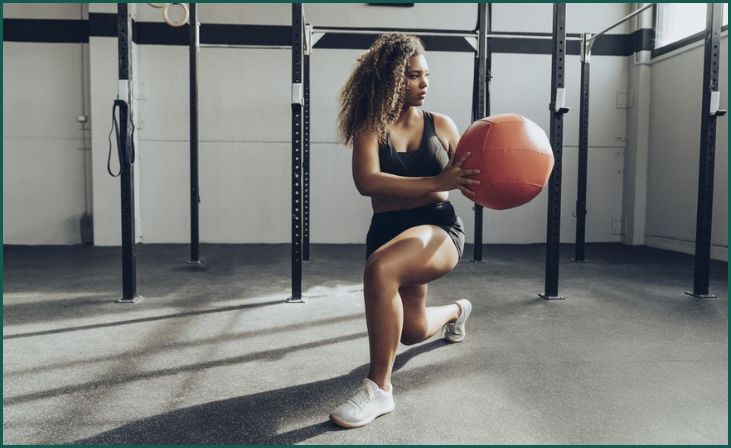Embarking on a fitness journey in your 30s and 40s is a powerful commitment to holistic well-being. These pivotal decades often bring changes in metabolism, muscle mass, and energy levels, making it crucial to adapt your exercise routine accordingly. In this comprehensive guide, we delve into the six best exercises for women in their 30s and 40s, curated to address specific needs and enhance overall health. From strength training to cardio, these workouts are tailored to empower you on your fitness journey, fostering resilience and confidence as you embrace the beauty of your body at every stage of life.
Table of Contents
Toggle6 Best Exercises For Women In Their 30s and 40s
Strength Training with Weights

In your 30s and 40s, prioritizing strength training with weights becomes imperative for overall health and well-being. This age range often witnesses a decline in muscle mass and bone density, making resistance training a key element in counteracting these natural processes. Engage in compound exercises such as squats, deadlifts, and bench presses, as they activate multiple muscle groups simultaneously.
Commence with a weight that challenges you while maintaining proper form. Gradually increase resistance to continually stimulate muscle growth and maintain metabolic health. Not only does strength training enhance physical strength, but it also contributes to the prevention of age-related conditions like osteoporosis.
Also Read: 8 Fantastic Belly Workouts for Women Over 50
Cardiovascular Workouts for Heart Health
Cardiovascular exercises take on heightened importance in your 30s and 40s, offering benefits beyond weight management. Regular activities such as brisk walking, jogging, cycling, or swimming are essential for elevating heart rate and promoting cardiovascular health.
Strive for a minimum of 150 minutes of moderate-intensity cardio each week or incorporate high-intensity interval training (HIIT) for time-efficient workouts. Cardiovascular exercises not only enhance endurance but also play a crucial role in mood regulation and stress reduction. These workouts contribute to improved circulation, blood flow, and overall cardiovascular fitness, reducing the risk of heart-related issues associated with aging.
Flexibility and Mobility Exercises

Emphasizing flexibility and mobility exercises is paramount as the body undergoes changes in your 30s and 40s. Incorporate activities like yoga or Pilates into your routine to enhance joint flexibility and range of motion. These exercises also contribute to improved balance and stability, reducing the risk of injuries that can be more prevalent with age.
Allocate dedicated time for stretching major muscle groups, with special attention to areas prone to tightness, such as the hips, shoulders, and lower back. Regular flexibility exercises not only foster functional fitness but also aid in maintaining an active and agile lifestyle.
Don't just scroll, subscribe!
BuzzTrail's unique web-stories are the cure for boredom you've been waiting for.
Core Strengthening for Stability
Prioritizing core strengthening exercises is essential for stability, posture, and overall functional fitness in your 30s and 40s. Include exercises like planks, Russian twists, and leg raises to target the abdominal muscles and lower back. A strong core not only improves balance but also alleviates back pain, a common concern as you age.
Consistent core workouts contribute to a toned midsection, supporting the spine and enhancing your ability to perform everyday tasks with comfort and ease. As a foundational element of fitness, core strengthening complements other exercises, creating a comprehensive approach to your overall well-being.
Mind-Body Connection through Mindfulness Practices
Nurturing the mind-body connection through mindfulness practices becomes increasingly important in your 30s and 40s. Incorporate activities such as meditation or tai chi into your routine to foster a holistic approach to fitness. Beyond the physical benefits, these practices enhance mental well-being by reducing stress and promoting better sleep—a crucial aspect of overall health in this life stage.
Dedicate a few minutes each day to mindfulness exercises, creating a tranquil space for relaxation and rejuvenation amidst the demands of daily life. The profound impact on mental clarity and emotional resilience extends the benefits beyond physical fitness, contributing to a more balanced and fulfilling life.
Also Read: 10 Balance Exercises for Seniors
Functional Training for Real-World Strength

In your 30s and 40s, integrating functional training into your workout routine is essential for maintaining real-world strength and agility. Focusing on exercises that mimic daily movements, such as lunges, squats, and step-ups, ensures that your fitness efforts translate into practical benefits in your day-to-day life.
Functional training not only enhances your ability to perform everyday tasks with ease but also reduces the risk of injuries related to daily activities. By mimicking real-world movements, these exercises engage multiple muscle groups simultaneously, promoting a more comprehensive and practical approach to fitness. Whether lifting groceries or climbing stairs, functional training ensures that your body is prepared for the demands of daily life, enhancing your overall quality of life in your 30s and 40s.
Conclusion
As you navigate through the transformative power of these exercises, it’s essential to recognize that fitness is a lifelong commitment. Beyond sculpting your physique, these workouts contribute to mental clarity, emotional balance, and improved overall well-being. Consistency is the key, and by incorporating these exercises into your routine, you are making a profound investment in a healthier, more empowered future. Remember, it’s not just about the destination; it’s about enjoying and celebrating the journey to a more vibrant you.
FAQs
Can I start these exercises if I’ve been inactive for a while?
Can I start these exercises if I’ve been inactive for a while?
Absolutely! It’s never too late to start. Begin at a comfortable pace, gradually increasing intensity as your fitness improves. If you have any health concerns, it’s advisable to consult with a fitness professional or healthcare provider before starting a new exercise regimen.
How often should I perform these exercises for optimal results?
How often should I perform these exercises for optimal results?
Aim for a minimum of three sessions per week, allowing your body adequate time to rest and recover between workouts. Adjust the frequency based on your individual fitness level, goals, and schedule. Listen to your body and make adjustments as needed to maintain a sustainable and enjoyable fitness routine.

